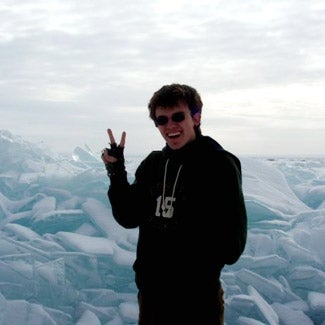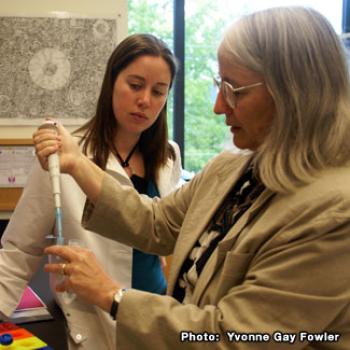On researching wolves in Minnesota
Aaron Kokotek ’11
“We heard howls in the distance, howled in response, and heard the wolf pack reply to our call.”

I decided for my second Winter Term to join the Audubon Center of the North Woods in their January Interim to study wolves and other large predators. I first heard about the project in the Biology department as a winter course in outdoor tracking and animal behavior. After more research, I was hooked on the idea. I was even able to get help from the Office of Winter Term to subsidize the costs of the plane ticket and some warmer winter clothes. Before I knew it, I was on a plane at the start of January to begin my wolf studies.
Minnesota is uniquely suited for wolf research because of its connection to the Canadian border: no matter how many wolves were killed in Minnesota before the bounty was lifted, more migrated across the border. They have continued to spread across the northern United States and now number around 3,500 in Minnesota. The wolves in Minnesota belong to a subspecies of the Grey Wolf known as the Great Plains Wolf. They are large animals, from four to six feet long, with thick hair and large footpads for surviving winter weather. They feed mostly on larger ungulates such as moose and elk, but a recent environmental shift has caused a change in diet to the white-tailed deer. They will also feed on smaller animals and carrion when possible.
The trip began two hours north of Minneapolis, with a group of 23 other students from around the United States. We started with classes in the Audubon Center about wolf, lynx, and mustelid ecology, before working on our practical experience. The first practical advice they gave us was how to dress properly for Minnesota weather, which drops as low as -60º Fahrenheit.
When we were let outdoors, we were shown how to build a quinzee: an outdoor shelter built of snow. Imagine an igloo with twigs sticking out of it at odd angles and you’ll have a good idea of what our finished products looked like. They were meant to be emergency bunkers in case we stayed out too late. We were also taught the basics of cross-country skiing and snowshoeing. Both are a lot harder than they look: skiing because of unintended movement and snowshoeing because snow is hard to break through for extended periods. After we could move around comfortably, we worked on tracking and exploration.
Tracking is harder in the snow than one would expect. Prints may be weathered, or the consistency of the snow may make them appear larger or smaller than the foot that made them. Animals also move in different ways: diagonal walking, direct registry, and bounding. We were able to see all of these on and off the trails. Most exciting for us was when we happened across wolf prints. Most were easily the size of my palm, if not larger. By studying the prints, we were able to determine approximately how many wolves had been using the same trail.
The trip also had several occasions to see wolves. For one thing, we were outside on most days, which allowed for the distinct possibility of seeing them if we were careful. When we traveled up to Ely, we were given the opportunity to track wolf radio collars from planes. Other people were lucky enough to see wolves, but my group was one of the unfortunate few that didn’t. We knew they were out there, though. Besides the footprints there were numerous RLU’s (raised leg urinations), scats, and the occasional kill site. We also had one amazing experience in which we heard howls in the distance, howled in response, and heard the wolf pack reply to our call. Even though I didn’t see any wolves, I was glad to have had the chance.
We were also able to visit the Wildlife Science Center, the Wildcat Sanctuary, the International Wolf Center, and the North American Bear Center. Each of these places connected us with researchers that each had different approaches to studying animals and how wildlife management should be best accomplished. It also gave us a great opportunity to connect and think about possible future internships. I would recommend this course to anyone interested in studying animal behavior or management, or to anyone who just likes to be outside. The weather may be cold, but you’ll be so busy that you won’t even notice.
Tags:
You may also like

On doing research during winter term
“I know of no other school where a professor will welcome a first-year student without a molecular biology background into their lab as willingly as Professor Allen welcomed me.”
Nina Cole ’12

On being a researcher
“I am excited about asking questions, picking apart ideas, and proposing new ways of thinking about problems. I obsess over the details of study designs and execution, all the while striving to be...
Olivia Winter ’08

On finding her path
“Oberlin opens up so many opportunities and challenges for students to explore life choices that even if you have absolutely no idea what you are heading for... you will always somehow find your...
Qian Cheng ’13